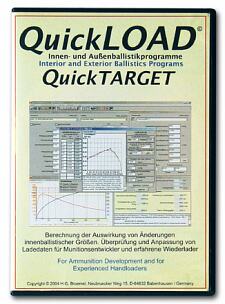QuickLOAD Software — Get the Latest Update NOW
If you have an older version of QuickLOAD, such as V3.1 shown above, then you should definitely upgrade. This will give you more complete and up-to-date cartridge, powder, and bullet data files.
 Got QuickLOAD software? Then it’s time to upgrade your data files — new data became available in January 2018. The makers of QuickLOAD offer inexpensive CDs with updated data files (for propellants and projectiles). These data update CDs will add the latest available powder, cartridge, and bullet files to your current version of QuickLOAD/QuickTARGET.
Got QuickLOAD software? Then it’s time to upgrade your data files — new data became available in January 2018. The makers of QuickLOAD offer inexpensive CDs with updated data files (for propellants and projectiles). These data update CDs will add the latest available powder, cartridge, and bullet files to your current version of QuickLOAD/QuickTARGET.
There are two update CDs now offered with data current through January 2018. One handles the older installations, QuickLOAD/QuickTARGET 3.0, 3.1, 3.2, 3.3, 3.4, and 3.5. A second update CD works for QuickLOAD/QuickTARGET 3.6, 3.8, and early 3.9. This second disk is primarily a data update.
V3.9 Update CD for V3.0 – V3.5
V3.9 Update CD for V3.6 – early V3.9
Price for either update disk is $15.95. In North America, order from Neconos.com, or call 800-451-3550 (9 am to 5 pm Pacific Time). In the United Kingdom, you can get the update disk from JMS Arms, Merrivale, London Road, Handcross, West Sussex, RH17 6BA, England, Phone: 01444 400126. In Europe you can order direct from QuickLOAD’s creator: Ing. Hartmut Broemel, Neubrecker Weg 15, D-64832 Babenhausen, Germany, fax/phone (+49) 0 6073 688481
QuickLOAD is a pretty amazing program. Using information for over 1200 cartridges, 250 powders, and 2500 bullet types, QuickLOAD allows you to predict velocities and pressures for your hand-loaded ammo. You can check predicted pressures with different powder choices and seating depths before loading an actual round. If you do not yet own QuickLOAD, you can now order the latest Version 3.9 of this unique software. Priced at $152.95, the latest version 3.9 contains all the updates through January, 2018 and is compatible with WINDOWS 2000, XP, VISTA, Windows 7, Winows 8 and Windows 10. QuickLOAD/QuickTARGET 3.9 can be purchased for $152.95 from Neconos.com. For a full explanation of the features and benefits of QuickLOAD software, click the link below.
» » READ Full QuickLOAD Software Review
Product tip from EdLongrange. We welcome reader submissions.EDITOR’S Comment: We believe every serious rifle hand-loader should own and use QuickLOAD. We have used this program for over a decade. It is invaluable in load development, particularly when testing a variety of bullets and when changing seating depths. This software is NOT a substitute for standard, conservative reloading practices. However QuickLOAD can very surprisingly effective in comparing cartridge performance and predicting the effects of changes in charge weight.














 Apply Dry-Lube Inside Case Necks
Apply Dry-Lube Inside Case Necks




